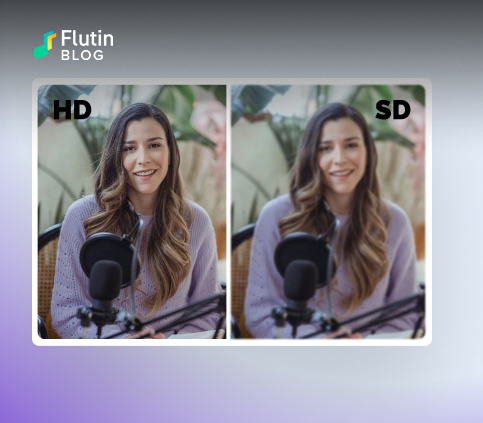In order for a viewer to enjoy live streaming, a good video resolution is essential. Video messages can be undermined by blurry images and pixelated faces. Knowing about video resolution – specifically HD vs SD – and how it impacts the quality of a live stream is a must for new streamers grasping the ins and outs of live streaming. While doing so, one may have a lot of queries. Is HD resolution better than SD? Does HD streaming garner more views? Today, we have all the answers for you. So, without further ado, here’s a breakdown of HD vs SD video resolutions.

When you first start out in live streaming, producing the highest quality video might not necessarily be your primary focus. Maybe you’re more concerned about social aspects than HD vs SD resolutions and frame rates. If we’re being honest, chatting with people in other countries is much more exciting than obsessing over your video quality. However, it won’t take long for you to realize that video quality matters. Live streaming, in fact, requires you to monitor stream quality quite closely. So, it’s important to understand some very basic parameters of video quality before we move on. One of them is video resolution.
What does video resolution mean?
Whenever you watch a video or view an image on your device, you’re actually looking at a very high number of very tiny squares. These squares are called pixels. Video resolution is the total number of these pixels in the photo frame or video.
Generally, higher video resolution implies more pixels and higher video quality. Quality is much more nuanced and complicated than that, of course. How well your stream will look on the viewer’s screen depends on frame rates, bitrates, and many other factors.
However, a sharp stream still requires a high resolution. You would probably write a big number x a slightly smaller number if you wanted to convey the full information about your live stream resolution. Resolution measures the height and width of your video frame. For example, 1280×720 means 1280 pixels wide and 720 pixels tall.
In a 1280×720 resolution, there are 16 pixels of width for every 9 pixels of depth, which is called an aspect ratio of 16:9. This is a common aspect ratio found on computer monitors and televisions. As long as you use 720 as the height, you presume a 16:9 aspect ratio when expressing resolution as a single number.
There is often a letter “p” following this number, such as “720p”. The “p” means “progressive” or “progressive scan”. This means that 720 horizontal lines (one line for each pixel of height) are displayed at once in a 720p video. Alternatively, an interlaced scan would display half of the lines simultaneously. “720i” is an interlaced scan, which isn’t as good as a progressive scan, especially when watching on television or on a computer monitor with lots of motion. Television broadcasts, however, still use it.
What does SD resolution mean?
There are some resolutions whose names are unrelated to their pixel count or scan. “SD”, which stands for “Standard Definition”, is one such name. This term refers to a 480i video format in television. The aspect ratio is usually 4:3. Compared with widescreen televisions or computer monitors, SD is older. It dates back to the days of DVDs and CRT monitors.
480p usually refers to a 16:9 aspect ratio when used to describe a live video stream. The SD resolution in that case would be 854×480. When it comes to streaming, 480p is a little below what you should probably stream.
What does HD resolution mean?
“HD” is short for “High Definition”. In HDTV, progressive or interlaced scanning is used for television display, a widescreen aspect ratio (16:9) is used, and the resolution is either 720 or 1080 pixels high. As HD consists of two resolutions, sometimes it is divided into HD-ready resolutions of 720p and 1080p or 1080i. In live streaming, HD streaming means streaming in either 720p or 1080p. The resolution is likely to be defined by the height in pixels, rather than whether it’s in full high definition, ready for high definition, or just high definition.
HD vs SD: Which is better?
It is crucial that you determine your limitations before you start streaming like a pro. Streams should always aim to give viewers the best viewing experience possible. Thus, it is necessary for you to stream as high a quality as possible.

Resources are necessary to ensure quality. YouTube supports up to 51Mbps upload speed to stream videos with the highest possible resolutions at the highest possible framerates. A stream at the lowest possible resolution will require less than 1Mbps. As your stream’s resolution increases, you’ll also require more processing power.
You have limitations in this regard. The best quality and no buffering will usually result in streaming at least 720p. If you are unable to do so, switching to 480p may keep you going while you research how to get a fast upload speed or acquire the technology required to broadcast at higher resolutions.
If you are aware that most of your viewers will be using mobile devices to see your streams, streaming in 480p may be useful. You might be able to stream at 480p on your mobile device if you use your data plan. Whenever possible, however, HD should always be preferred over SD, and full HD should be preferred if the hardware and bandwidth allow it.
HD vs SD: Which is better for multistreaming?
The decision to downgrade to 480p might seem like a good one if you want to stream to multiple platforms simultaneously. Multi-platform streaming, after all, should result in greater bandwidth and processing demands. When this is the case, lowering the quality is an effective way to meet some of these demands.
Choosing the right multistreaming tool can make a big difference here. It will take a lot of bandwidth to run a multistreaming hardware encoder. Your bandwidth and processing power will be drained if you use multistreaming software. But, platforms like Flutin make multistreaming as seamless and easy as streaming to a single platform.

If you do not have adequate bandwidth or processing power, streaming in 480p can be a good option. It’s important to know, however, that a serious streamer is expected to provide HD resolutions of 720p and 1080p. Head over to Flutin today and offer your viewers the experience they deserve.
Related Topics
Join our official streaming community and get tips to improve your social presence, hacks to increase brand engagement and generate more revenue.
